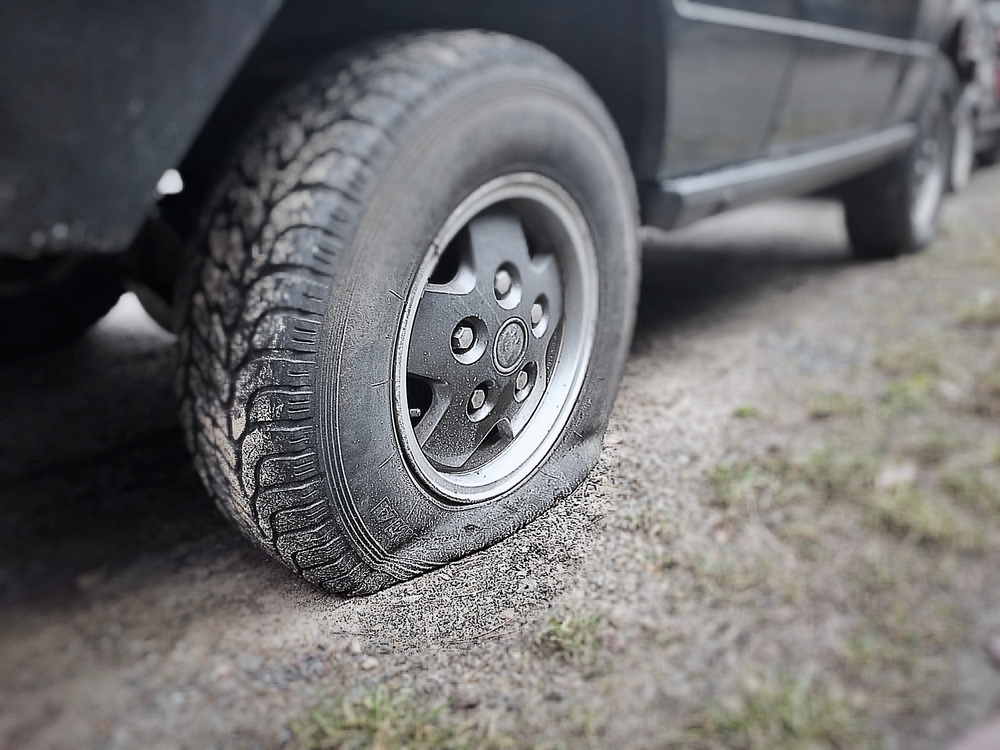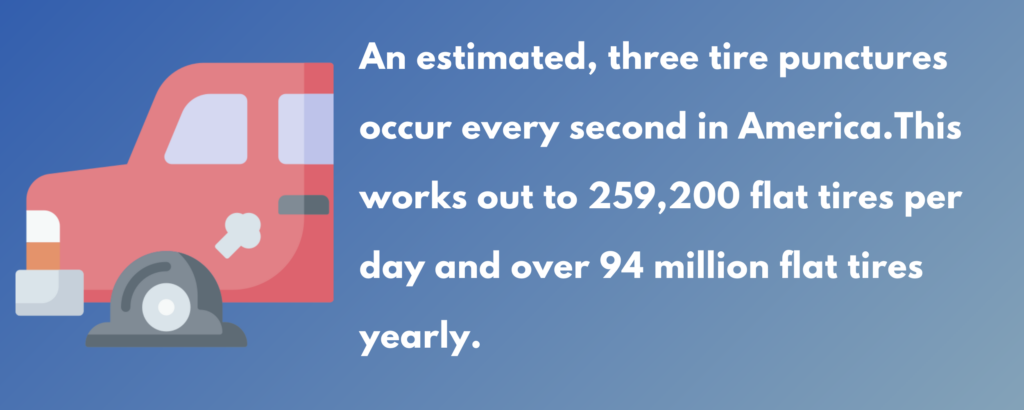Driving can be stressful – from running into bumper-to-bumper traffic and being on the receiving end of road rage, to running low on fuel and driving in poor weather conditions. But one of the most anxiety-inducing scenarios for many drivers is getting a flat tire. It ranks among the top three causes of vehicle breakdowns at the American Automobile Association (AAA), yet some drivers do not know how to fix a puncture or replace a tire. To find out everything you need to know about flat tires, including how to reduce the risk of getting one in the first place, read on.

14 ALARMING FLAT TIRE STATISTICS
- An average American driver will have up to five flat tires in a lifetime.
- As per the latest estimates, there are three tire punctures per second in the U.S. This works out to 259,200 flat tires per day and over 94 million flat tires each year.
- Annually, one in three vehicles in America is likely to have at least one tire puncture.
- Only one-third of new cars came equipped with a spare tire.
- Only 0.08% of American drivers carry puncture repair kits and inflators.
- 27% of roadside emergencies are tire related.
- Sharp objects on the road account for 64% of tire punctures.
- A recent survey revealed that 74% of drivers know how to change a tire. However, only 57% of those who experienced a flat tire chose to change it themselves, with 22% opting to call roadside assistance instead.
- The nationwide average cost of flat tire repair hovers around $22.
- The National Highway Traffic Safety Administration (NHTSA) reports that cars with worn-out, low-tread tires are three times more likely to be involved in a collision than tires with sufficient tread.
- The NHSTA confirmed that 664 people died from tire-related crashes in 2020.
- A 2021 study by the AAA and U.S. Tire Manufacturers Association found that 70% of drivers had not checked their tire pressure in the last 30 days, even though monthly checks are recommended.
- As of 2022, 15% of new vehicles came with run-flat tires as standard, predominantly on models from BMW, Mercedes-Benz, and Mini. Run-flat tires allow cars to run for up to 50 miles with a puncture.
- Data from tire manufacturer Bridgestone showed that flat tires accounted for 9% of automotive service sales in the U.S., with Oklahoma City having the highest rate of flat tire repairs (23%).

WHAT IS THE DIFFERENCE BETWEEN A FLAT TIRE AND A TIRE BLOWOUT?
People often use the terms “flat tire” and “blowout” interchangeably, but they are, in fact, two different scenarios:
A flat tire occurs when there is a gradual loss of pressure due to a puncture or leakage. The car’s tire pressure warning system will afford the driver time to pull over in a controlled manner. Drivers can temporarily repair flat tires at the roadside but should aim to replace them as soon as possible, ideally on the same day.
A blowout, as the name suggests, is a much more explosive and rapid loss of pressure. Tire damage, overloading, or overheating cause pressure to build up and burst through the tire. This eruption produces a loud noise and irreparable damage to the wheel. Cars with a blowout can be hard to control and should be brought to a gradual stop at the side of the road, without sudden braking.
WHAT ARE THE 5 MOST COMMON CAUSES OF A FLAT TIRE?
- Debris and potholes. Sharp objects and uneven road surfaces can damage the exterior of the tire. The puncture may not be immediately obvious as the tire may take days or weeks to deflate. Drivers should be vigilant for any potential hazards on the road and attempt to drive around them if safe to do so.
- Old tires. Worn, old tires are prone to disintegration and surface cracks, meaning failure is likely. Extreme temperatures accelerate this damage. Drivers should replace tires approximately every six years, irrespective of mileage, or when they have less than 2/32” of tread. In addition, rotating tires every 5000-8000 miles will help to avoid uneven wear.
- Incorrect tire pressure. Under-inflated tires increase stress on tire components and promote heat build-up. On the other hand, overinflation can cause internal damage to the tire, weakening the structure. Drivers can find the recommended pressure level for their car in the owner’s manual or on the vehicle’s placard. Tires should be checked with a pressure gauge every month, including any spares.
- Valve stem leakage. If there is no sign of damage to the outside of the tire, drivers should check the valve – the small device used for inflation. It can become damaged or corroded, allowing pressure to escape. A mechanic can identify and replace a compromised valve.
- Vandalism. Deliberate damage to the tires can be an unexpected and unfortunate reality. A visual check will reveal severe damage or the tire pressure system will alert the driver to any failure. Parking a car in a locked garage instead of on the street will minimize the risk of vandalism.
WHAT DO I NEED TO CHANGE A FLAT TIRE?
You should only attempt to change a flat tire if you feel confident you know what to do. Here are the essential tools required:
Warning triangles or flares. When stranded at the side of the road, it is important to warn oncoming traffic of your presence. Triangles or flares will make you more visible to drivers, encouraging them to slow down and switch lanes to give you room.
Spare tire. The obvious part! Depending on your vehicle, you may have a full-size spare wheel (rare), a temporary space-saver wheel (also known as donut wheel), or none, as many modern cars don’t have a spare tire as standard. The space-saver spare tire is a temporary fix; its only job is to get you to the nearest mechanic.
Car jack. Most likely to be a scissor jack, as it is lightweight and portable. With minimal energy required, the device raises your car so that you can easily remove and replace the wheel.
Lug wrench. Also known as a tire iron, the lug wrench loosens and tightens lug nuts on wheels.
Pressure gauge[Optional]. Once the new tire is on, you should ideally check the pressure is at the recommended level.
If you have difficulty replacing the tire yourself, call for a tow truck or roadside assistance.
Conclusion
A flat tire is not only inconvenient, but it can also be dangerous. Although driver vigilance and a regular schedule of checks will reduce the likelihood of a puncture, sometimes they are unavoidable. Drivers should prepare for all eventualities by carrying a spare tire and tools, keeping a repair kit handy, or simply having road assistance on speed dial.
